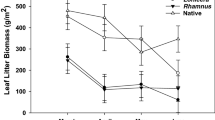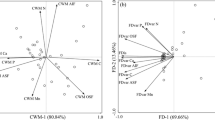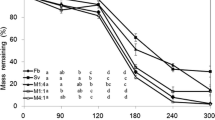Abstract
In Hawaii, invasive plants have the ability to alter litter-based food chains because they often have litter traits that differ from native species. Additionally, abundant invasive predators, especially those representing new trophic levels, can reduce prey. The relative importance of these two processes on the litter invertebrate community in Hawaii is important, because they could affect the large number of endemic and endangered invertebrates. We determined the relative importance of litter resources, represented by leaf litter of two trees, an invasive nitrogen-fixer, Falcataria moluccana, and a native tree, Metrosideros polymorpha, and predation of an invasive terrestrial frog, Eleutherodactylus coqui, on leaf litter invertebrate abundance and composition. Principle component analysis revealed that F. moluccana litter creates an invertebrate community that greatly differs from that found in M. polymorpha litter. We found that F. moluccana increased the abundance of non-native fragmenters (Amphipoda and Isopoda) by 400% and non-native predaceous ants (Hymenoptera: Formicidae) by 200%. E. coqui had less effect on the litter invertebrate community; it reduced microbivores by 40% in F. moluccana and non-native ants by 30% across litter types. E. coqui stomach contents were similar in abundance and composition in both litter treatments, despite dramatic differences in the invertebrate community. Additionally, our results suggest that invertebrate community differences between litter types did not cascade to influence E. coqui growth or survivorship. In conclusion, it appears that an invasive nitrogen-fixing tree species has a greater influence on litter invertebrate community abundance and composition than the invasive predator, E. coqui.



Similar content being viewed by others
References
Allison SD, Nielsen C, Hughes RF (2006) Elevated enzyme activities in soils under the invasive nitrogen-fixing tree Falcataria moluccana. Soil Biol Biochem 38:1537–1544. doi:10.1016/j.soilbio.2005.11.008
Austin AT, Vitousek PM (2000) Precipitation, decomposition and litter decomposability of Metrosideros polymorpha in native forests on Hawai’i. J Ecol 88:129–138. doi:10.1046/j.1365-2745.2000.00437.x
Beard KH (2007) Diet of the invasive frog, Eleutherodactylus coqui, in Hawaii. Copeia 2007:281–291. doi:10.1643/0045-8511(2007)7[281:DOTIFE]2.0.CO;2
Beard KH, Pitt WC (2005) Potential consequences of the coqui frog invasion in Hawaii. Divers Distrib 11:427–433. doi:10.1111/j.1366-9516.2005.00178.x
Beard KH, Vogt KA, Kulmatiski A (2002) Top-down effects of a terrestrial frog on forest nutrient dynamics. Oecologia 133:583–593. doi:10.1007/s00442-002-1071-9
Beard KH, Eschtruth AK, Vogt KA, Vogt DJ, Scatena FN (2003) The effects of the frog Eleutherodactylus coqui on invertebrates and ecosystem processes at two scales in the Luquillo Experimental Forest, Puerto Rico. J Trop Ecol 19:607–617. doi:10.1017/S0266467403006011
Borror DJ, Triplehorn CA, Johnson NF (1989) An introduction to the study of insects. Saunders College Publishing, Philadelphia
Chapin FS III, Reynolds H, D’Antonio CM, Eckhart V (1996) The functional role of species in terrestrial ecosystems. In: Walker B, Steffen W (eds) Global change in terrestrial ecosystems. Cambridge University Press, Cambridge, pp 403–430
Crews TE, Farrington H, Vitousek PM (2000) Changes in asymbiotic, heterotrophic nitrogen fixation on leaf litter of Metrosideros polymorpha with long-term ecosystem development in Hawaii. Ecosystems (N Y, Print) 3:386–385. doi:10.1007/s100210000034
Effland MJ (1977) Modified procedure to determine acid insoluble lignin in wood and pulp. TAPPI 60:143–144
Eldredge LG, Evenhuis NL (2002) Numbers of Hawaiian species for 2000. Bish Mus Occas Pap 68:71–78
Giambelluca TW, Nullet MA, Schroeder PA (1986) Rainfall atlas of Hawai’i. Department of Land and Natural Resources, Honolulu
Gillespie RG, Reimer N (1993) The effect of alien predatory ants (Hymenoptera: Formicidae) on Hawaiian endemic spiders (Araneae:Tetragnathidae). Pac Sci 47:21–33
Goergen E, Daehler CC (2001) Reproductive ecology of a native Hawaiian grass (Heteropogon contortus; Poaceae) versus its alien competitor (Pennisetum setaceum; Poaceae). Int J Plant Sci 162:317–326. doi:10.1086/319587
Hansen RA (2000) Effects of habitat complexity and composition on a diverse litter microarthropod assemblage. Ecology 81:1120–1132
Harmon ME, Lajtha K (1999) Analysis of detritus and organic horizons for mineral and organic constituents. In: Robertson GP, Coleman DC, Bledsoe CS, Sollins P (eds) Standard soil methods for long-term ecological research. Oxford University Press, New York, pp 143–165
Heneghan L, Coleman DC, Zou X, Crossely DA Jr, Haines BL (1999) Soil microarthropod contributions to decomposition dynamics: tropical-temperate comparisons of a single substrate. Ecology 80:1873–1882
Holmes RT, Schultz JC (1988) Food availability for forest birds: effects of prey distribution and abundance on bird foraging. Can J Zool 66:720–728
Hughes RF, Denslow JS (2005) Invasion by an N-2-fixing tree alters function and structure in wet lowland forests of Hawaii. Ecol Appl 15:1615–1628. doi:10.1890/04-0874
Hughes RF, Uowolo A (2006) Impacts of Falcataria moluccana invasion on decomposition in Hawaiian lowland wet forests: The importance of stand-level controls. Ecosystems (N Y, Print) 9:977–991. doi:10.1007/s10021-005-0083-9
Jacobs J (1974) Quantitative measurement of food selection. Oecologia 14:413–417. doi:10.1007/BF00384581
Jensen M (1999) Trees commonly cultivated in Southeast Asia: An illustrated field guide. RAP Publication 13. Food and Agricultural Organization, Regional Office for Asia and the Pacific (RAP), Bangkok
Joel G, Aplet G, Vitousek PM (1994) Leaf morphology along environmental gradients in Hawaiian Metrosideros polymorpha. Biotropica 26:17–22. doi:10.2307/2389106
Kraus F, Cambell EW, Allison A, Pratt T (1999) Eleutherodactylus frog introductions to Hawaii. Herpetol Rev 30:21–25
Nullet D, Sanderson M (1993) Radiation and energy balances and air temperatures. In: Sanderson M (ed) Prevailing trade winds: weather and climate in Hawaii. University of Hawaii Press, Honolulu, pp 37–55
Ostertag R, Verville JH (2002) Fertilization with nitrogen and phosphorus increases abundance of non-native species in Hawaiian montane forests. Plant Ecol 162:77–90. doi:10.1023/A:1020332824836
Ponsard S, Arditi R, Jost C (2000) Assessing top-down and bottom-up control in a litter-based soil macroinvertebrate food chain. Oikos 89:524–540. doi:10.1034/j.1600-0706.2000.890312.x
Pough FH, Taigen TL, Stewart MM, Brussard PF (1983) Behavioral modification of evaporative water loss by a Puerto Rican frog. Ecology 64:244–252. doi:10.2307/1937072
Price S (1983) Climate. In: Armstrong RW (ed) Atlas of Hawaii. University of Hawaii Press, Honolulu, pp 59–66
Rosemond AD, Pringle CM, Ramirez A, Paul MJ (2001) A test of top-down and bottom-up control in a detritus based food web. Ecology 82:2279–2293
Sin H, Beard KH, Pitt WC (2008) An invasive frog, Eleutherodactylus coqui, increases new leaf production and leaf litter decomposition rates through nutrient cycling in Hawaii. Biol Invasions 10:335–345. doi:10.1007/s10530-007-9133-x
Stewart MM, Woolbright LL (1996) Amphibians. In: Reagan DP, Waide RB (eds) The food web of a tropical rainforest. The University of Chicago Press, Chicago, pp 273–320
Vitousek PM (1986) Biological invasions and ecosystem properties: can species make a difference? In: Mooney HA, Drake JA (eds) Ecology of biological invasions of North America and Hawaii. Springer-Verlag, New York, pp 163–176
Vitousek PM (1998) Foliar and litter nutrients, nutrient resorption, and decomposition in Hawaiian Metrosideros polymorpha. Ecosystems (N Y, Print) 1:401–407. doi:10.1007/s100219900033
Vitousek PM, Walker LR (1989) Biological invasion by Myrica faya in Hawaii: plant demography, nitrogen fixation, ecosystem effects. Ecol Monogr 59:247–265. doi:10.2307/1942601
Wagner WL, Herbst DR, Sohmer SH (1990) Manual of the flowering plants of Hawaii. University of Hawaii Press, Honolulu
Wallace JB, Eggert SL, Meyer JL, Webster JR (1999) Effects of resource limitation on a detrital-based ecosystem. Ecol Monogr 69:409–442
Wardle DA (2002) Communities and ecosystems: linking the aboveground and belowground components. Princeton University Press, Princeton
Wolfe EW, Morris J (1996) Geologic map of the Island of Hawaii. U.S. Geological Survey miscellaneous geologic investigations series map I-2524-A, scale 1:100, 000. USGS, Honolulu
Woolbright LL (1985) Patterns of nocturnal movement and calling by the tropical frog Eleutherodactylus coqui. Herpetologica 41:1–9
Woolbright LL (1989) Sexual dimorphism in Eleutherodactylus coqui: selection pressures and growth rates. Herpetologica 45:68–74
Woolbright LL, Hara AH, Jacobsen CM, Mautz WJ, Benevides FL Jr (2006) Population densities of the Coqui, Eleutherodactylus coqui (Anura: Leptodactylidae) in newly invaded Hawaii and in native Puerto Rico. J Herpetol 40:122–126. doi:10.1670/79-05W.1
Acknowledgements
Funding was provided by the Jack H. Berryman Institute and the Hawaii Invasive Species Council (Hawaii Department of Land and Natural Resources). We thank M. Higashi, M. Tuttle, A. Huff, J. Verlinde, K. Crowell, D. Grant, S. Bisrat, C. Richins, and S. Selamet for field and laboratory assistance; S. Durham for statistical advice; R. Ryel for vehicle use; and D. Preston and R. Snelling for invertebrate identification to species and origin. Procedures were performed with the approval of Utah State University’s Institutional Animal Care and Use Committee permit number 1145R.
Author information
Authors and Affiliations
Corresponding author
Rights and permissions
About this article
Cite this article
Tuttle, N.C., Beard, K.H. & Pitt, W.C. Invasive litter, not an invasive insectivore, determines invertebrate communities in Hawaiian forests. Biol Invasions 11, 845–855 (2009). https://doi.org/10.1007/s10530-008-9298-y
Received:
Accepted:
Published:
Issue Date:
DOI: https://doi.org/10.1007/s10530-008-9298-y




